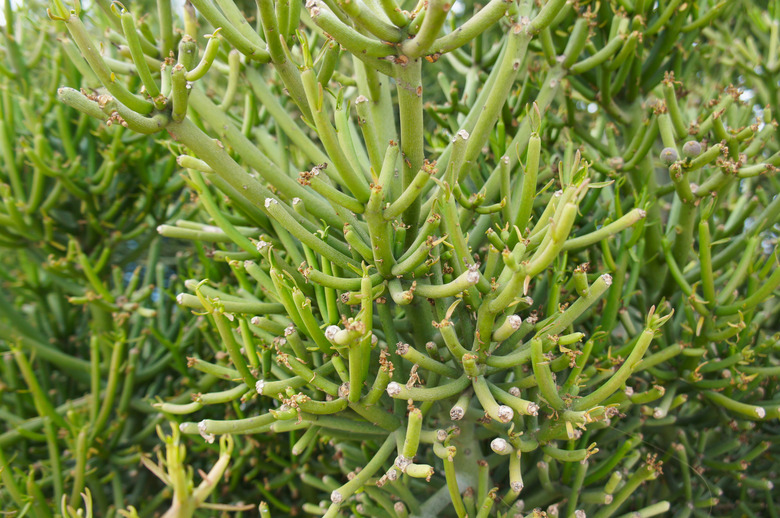How To Propagate A Pencil Cactus Plant
We may receive a commission on purchases made from links.
The unique, pencil-thin branches of the pencil cactus (Euphorbia tirucalli) make it a focal point in an indoor garden. Hardy in frost-free gardens in U.S. Department of Agriculture plant hardiness zones 9 through 12, this native of Africa, India and Indonesia is usually grown as a houseplant. To propagate a pencil cactus plant, also known as African milkbush and Indian tree spurge, pot the succulent cuttings in moist sand or cactus mix but be mindful that the milky sap is irritating to the eyes and skin.
About the Pencil Cactus Plant
About the Pencil Cactus Plant
Though the common name includes "cactus," the pencil cactus is actually a succulent. Like nearly all members of the Euphorbiaceae family, when broken or cut, the branches ooze a white latex sap. While the species plant grows up to 30 feet tall in its native habitat, when grown indoors, it can be pruned to stay under 8 to 10 feet tall and 5 feet wide. The colorful red-gold cultivar Euphorbia tirucalli 'Rosea' remains smaller at 3 feet tall and 2 feet wide, while Euphorbia tirucalli 'Sticks on Fire' grows up to 6 to 8 feet tall.
As the plant matures, the central stem becomes thick and woody. The primary branches also thicken and turn brown. The pencil-thin growths that give the plant its common name are the new branches that may be green, red or orange-gold depending on the cultivar. Inconspicuous flowers occasionally appear at the intersections of the branches, while tiny leaves grow at the branch tips.
Pencil Cactus Care
Pencil Cactus Care
Pencil cactus and other succulent care is relatively simple. Place the plant in a sunny south or south-east window so it receives as much sun as possible. Otherwise, a grow light or fluorescent light fixture suspended a few inches above the plant can supplement the available light. Keep the plant at 65 to 70 degrees Fahrenheit.
Water once every two or three weeks in summer and then reduce watering to once a month in fall. In winter, don't water at all and then resume watering in spring as the weather warms. Fertilize with a slow-release 10-10-10 or 20-20-20 fertilizer in spring or weekly with a liquid fertilizer diluted to one-quarter strength.
Propagate a Pencil Cactus Plant
Propagate a Pencil Cactus Plant
Before you begin, put on safety goggles, gloves, long sleeves and other protective gear to protect your eyes and skin from the milky sap, which can cause temporary blindness, skin irritation and, in sensitive individuals, breathing problems. If ingested, the sap and all parts of the plant may result in digestive issues, including vomiting and diarrhea. Also sterilize your cutting tools by wiping the blades with rubbing alcohol. Avoid using chlorine bleach solutions; the bleach pits the metal blades of your tools.
Snip 4- to 6-inch cuttings from the plant just above an intersection of the young branches. Set the cuttings aside for a week until the cut end has dried and formed a callous. Insert the cut end into moist sand or cactus mix and put it in a brightly lit location, out of direct sun. Water lightly to keep the potting mix barely moist until new growth appears.
Repot Your Pencil Cactus
Repot Your Pencil Cactus
When it has outgrown its pot, repot your pencil cactus plant. If possible, wait until summer when the weather is warm. Be careful when removing the plant from the pot, as the thin branches are fragile. Trim any dead, broken or diseased roots and then treat the cut ends with a fungicide.
Put new cactus mix in the flower pot and nestle the plant in the potting mix. Fill in around the roots with the fresh mix until the plant is at the same depth as it was in the original pot. Wait for a week before watering and then water lightly to barely moisten the potting mix.
